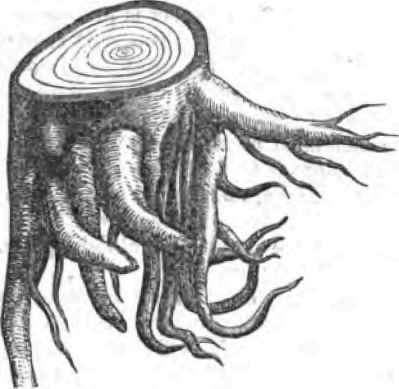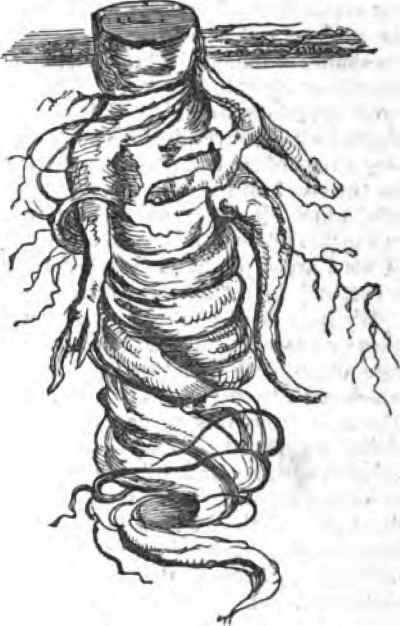Elvaston Castle. A Leaf From My Note-Book. Continued
Description
This section is from "The Horticulturist, And Journal Of Rural Art And Rural Taste", by P. Barry, A. J. Downing, J. Jay Smith, Peter B. Mead, F. W. Woodward, Henry T. Williams. Also available from Amazon: Horticulturist and Journal of Rural Art and Rural Taste.
Elvaston Castle. A Leaf From My Note-Book. Continued
Do it at the proper time, and judiciously; they are, with few exceptions, perfectly under control." "I thought Douglas Fir was an exception, and that it was only handsome from seed?" "Of all the magnificent specimens on the place, there are only about half a dozen of seedlings." " What is the object of those pieces of paper at regular distances along the top of that Yew hedge?" With a smile: " They are to cover the grafts of the Golden Yew that I put in a few days ago." "What! graft at this season of the year - July?" "All those trees have been grafted in the same way, by what, you know, is called herbaceous grafting, taking the soft yonng wood of this season's growth, and inserting it into the shoot of the same age on the stock, and they unite in a few hours 1" Make a note of thai.
From the east front of the house, the east avenue extends ten miles in a straight, uninterrupted view, which is not used as an entrance, but merely as a prospect. A walk of about thirty feet wide extends half a mile, or as far as the ha-ha; within this space, the majestic Horse-Chestnut has been replaced by the Araucaria, Cryptomeria, Taxodium sempervirens, Deodars, Cedars of Lebanon, and Picea pinsapo, disposed with a gracefully waved outline-. As you enter this amazing vista, you have, on your right and left, specimens of Picea nobilis, each twelve feet high, and about the largest in England, of the most symmetrical form, and without a fault, surpassing in beauty the famed Araucaria excelsa (Norfolk Island Pine), and grown from cuttings planted out when only three inches high. Onward, are magnificent trees of Araucaria imbricata, thirty-five feet high, planted on mounds, and clothed to the ground with their distinct and unique foliage. These trees have been eighteen years planted, so that their average growth has been about two feet a year.
Onward was the Cryptomeria, with its graceful, airy form, and pendulous branches, contrasting with the stiff habit and upright mien of the Araucaria. How grand, how expansive the view! What will those new features attain? Shall I see it again in twenty years!
To the left of this prospect, and entirely obscured by mounds and planting, is the tame sheet of water of 1831, now a magical lake, interspersed with islands, peninsulas, promontories, and steeps, of the most verdant grass, artificial rockwork, palisades, and geological formations, all having been brought many miles to adorn this magical spot, to which you are gently drawn by the musical whisperings of a secluded waterfall. In your search, you cast your eye on a view called the " Vista of Spondon," being a church, with its towering spire, three miles across the lake, forming the termination of this picturesque view. At your feet is a beautiful boat with golden oars, in which we paddled from island to island, viewing and comparing the growth of trees, the formation of artificial rocks, and the design of the planter, where the towering Douglas and Norway Firs were flanked by our Hemlock Spruce, which makes an agreeable tree for rock and water scenes; its delicate foliage and drooping branches kissing the ripple of the silver lake, adding new charms to the scene; one of our most common trees luxuriating in those-fairy isles with native splendor.
Those trees were not planted on low mud islands, but on high, artificial hills, nearly every foot of which had cost a shilling to the spirited owner, whose great delight was to employ the poor in creating those objects of his fancy. His sole pleasure was planning, planting, and replanting - the cost rarely estimated; the question was, can it be done? On the margins and inlets of this romantic sheet of water, great effect is produced by the shades of foliage. The Austrian, Corsican, and Norway Pine, give dark shades; the Silver, Scotch, Bhotan, and Sabin Pines, give light shades, using the Deodar, on all occasions, for union of design; the Khutrow Cembran and Silver give green shades, with an occasional Yew, whose histories go back into other centuries, and give a tone of ancient and modern granden r, which must be seen to be fully realized. On the south of the lake, and very near the mansion, is formed a grotto and fountain, where all the gems of dwarf evergreen-trees, lava, and rocks, are collected, and rather systematically arranged, which appears to have been the prevailing taste of his Lordship. How wonderful are the productions of the vegetable kingdom! it can only be realized in collections thus brought together.
We have been admiring the rapid growth of many of the firs and pines, frequently exceeding five feet in a season. What are we now to say of those miniature affairs, such as Abies clanbrasiliana; those Pigmy and Hudson Firs, some of which were twenty years old, and had not attained the height of as many inches. The view from this point across the lake, was on the artificial ruins of an old castle, composed of rocks, pieces of buildings, tufa and limestone formations, covered with ivy and wild flowers, all erected within a few years, and appearing as having stood for ages on a spot that was a low meadow as late as 1831. All the walks in the vicinity of this lake, and, indeed, for miles, were asphalted, by taking four parts of clean gravel, and one part of quicklime, and gas tar sufficient to make the whole of the consistency of mortar; this was heated on plates of iron, and laid down whilst hot about two inches thick, and has -become as hard as marble.
So much was I absorbed with what I could barely realize to be real, that 10½ o'clock of the night found me under the soft silver beams of the moon, still enjoying those magical scenes, where I had seen but yesterday, comparatively, the muddy pool skirting the field of the mower. I retired to rest, but found none for my excited imagination. The early dawn (2½ o'clock) found me alone amidst the golden-crowned Yews of the winter garden; not altogether alone, I found, for there followed me the silent watchman of the night, who has trod the rounds for seventeen years, amongst those, to him, no doubt, monotonous scenes.
The thorough secret of the successful growth of all I have seen, consists in a complete system of under-drainage, the ground being so level the main drain had to be extended one and a half miles in a direct line. All the leading trees are planted on mounds of earth. No tree was too large to remove, and none too small to plant; every power and facility was on the spot; all fibrous roots, on removal, were securely protected; copious waterings were given; strong stays of No. 8 wire were fixed from the ground to various parts of the tree, to prevent its being displaced after planting; evergreens were successfully removed at all times, but preference given just before their growth. Even a Yew that had stood for three hundred years, was brought from a distance, and, the second year after removal, made a luxuriant growth. Another striking fact, was planting the best that could be got; from three inches to three feet was the general height of all those now unique specimens of rare Evergreens. Seedlings, cuttings, layers, and grafts, all were alike acceptable; if they were not x>f the proper form, the knife was freely applied to either root or branch.
Where roots had been confined in pots before planting, they were washed from the old soil, carefully ex tedded, fresh soil placed amongst them, freely watered a few times, and success was the result; experience proved this to be the true plan, for the roots, as grown in the pots, take the screw form, and, when planted a few years, tend actually to grow the tree out of the ground, and, in a few years more, a storm prostates the specimen by the tendency of the screw throwing it upwards. The most critical judges cannot now decide whether the tree was originally a cutting layer or graft.


The whole energies of means and art have not been entirely directed, during the time, to the grand achievement of an evergreen pleasure-ground and winter garden. There is a fruit and vegetable garden, with graperies, peach-houses; forcing-houses, pine-pits, hot and cold walls, and all their accompaniments, kept in corresponding order, flourishing and fruitful; but these are every-day affairs. The achievements in the grounds, and the planting, their growth and keeping, in the short space of twenty years, have no precedent in modern landscape gardening. The place viewed now (in 1857) will be found densely covered; the growth has been exuberant; the trees and shrubs having, for effect, been planted thick, they are constantly engaged in removing, to clothe other grounds, their present owner being still desirous to keep up and protect the character of the place, which is now generally appreciated by the privilege granted and previously alluded to. One beautiful fact connected with the establishment is, that the lord and the laborer are all advocates of the temperance cause, giving a comfort to all the cottages, families, and people of the place.
Continue to:


